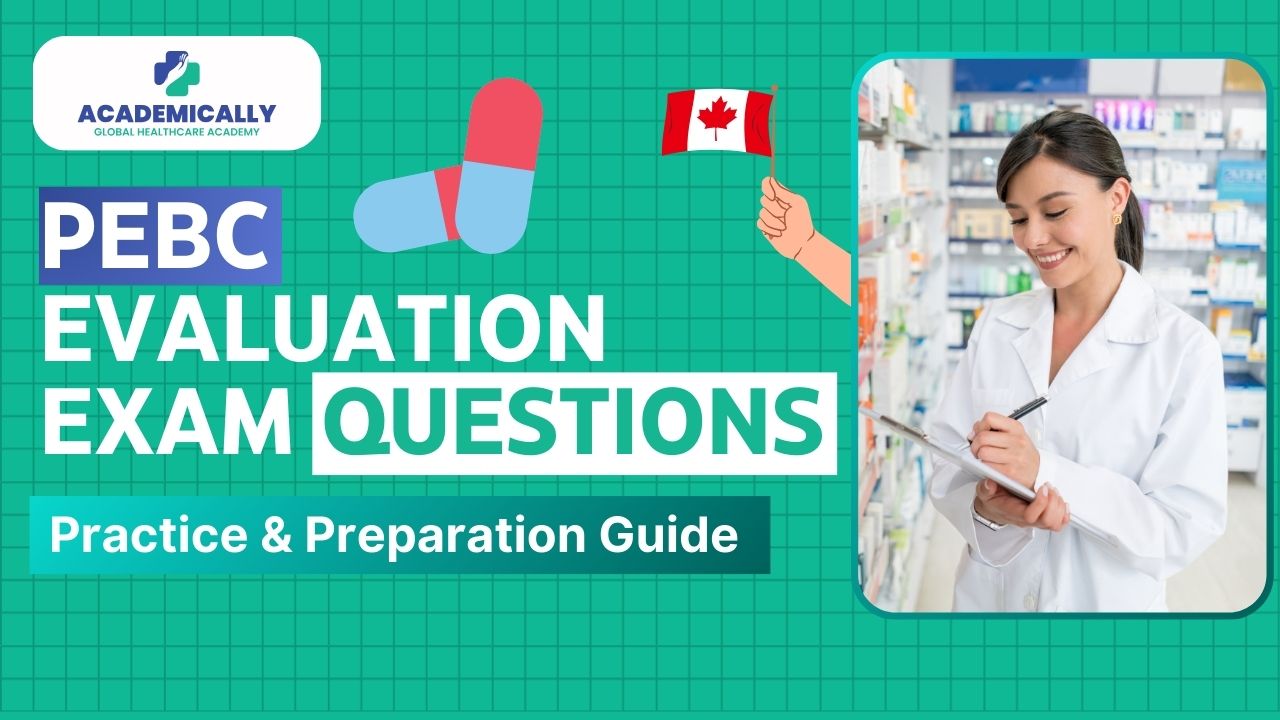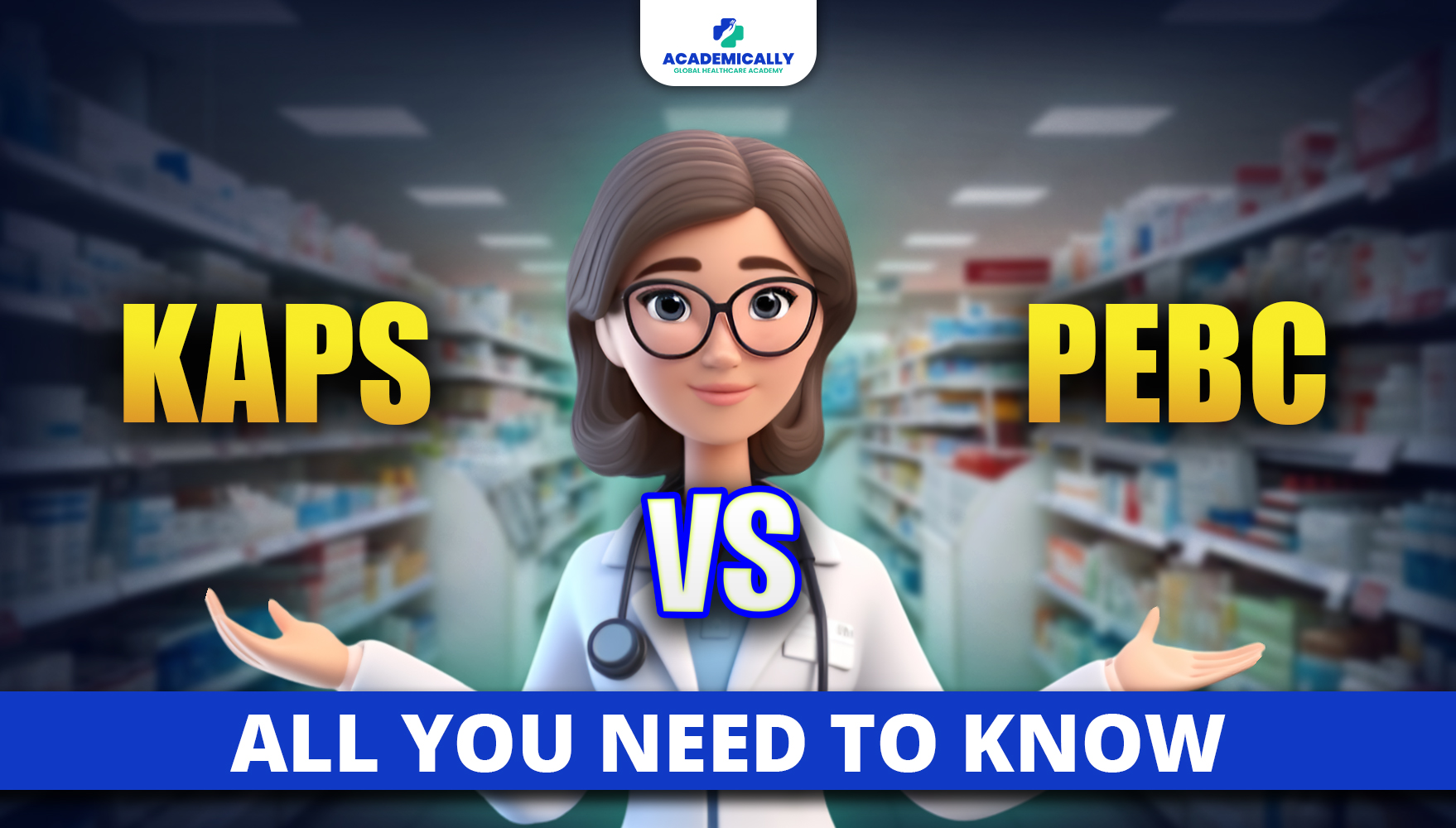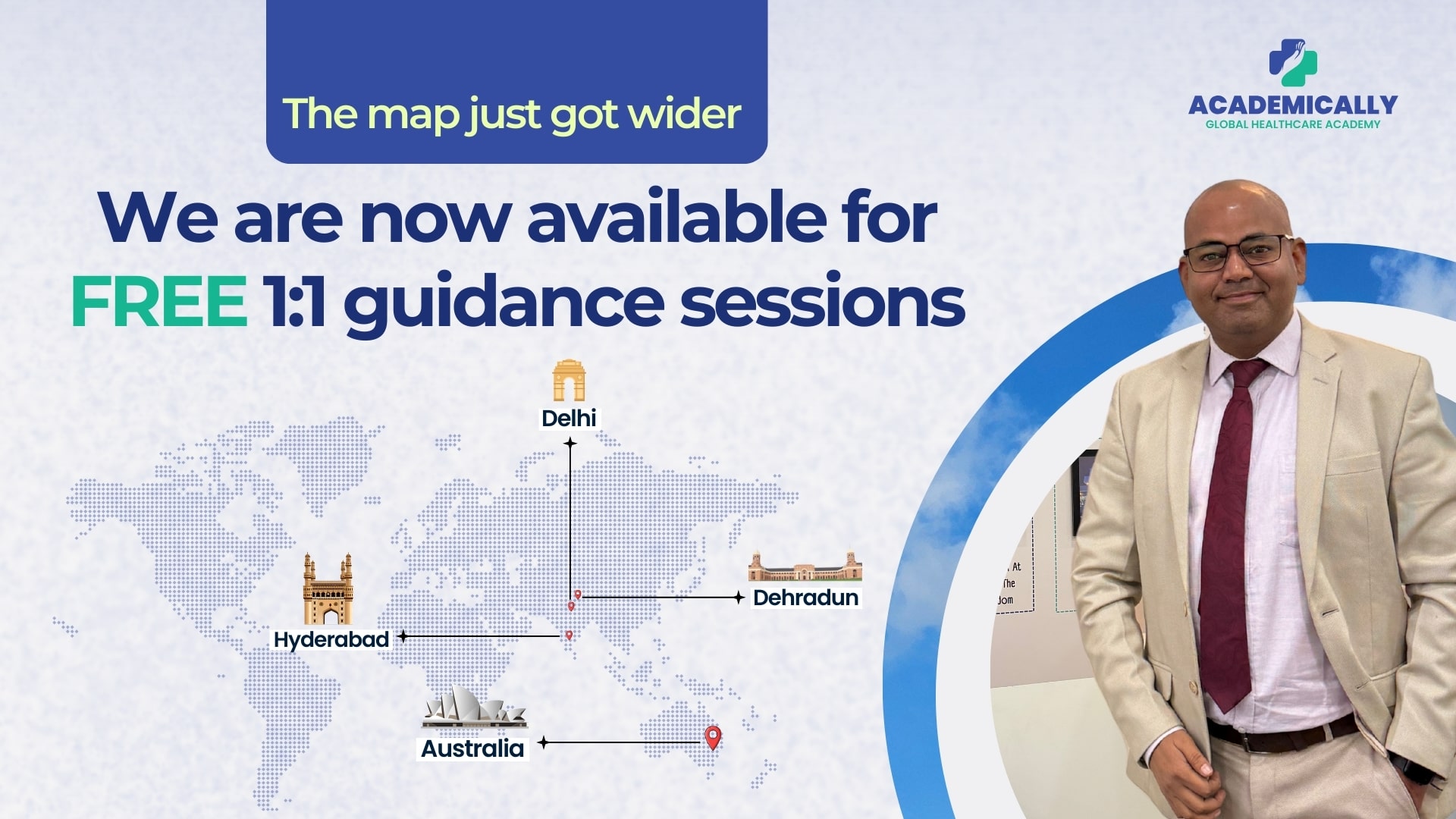The Pharmacy Examining Board of Canada (PEBC) Evaluation Exam is the first major step for internationally trained pharmacists who wish to practice in Canada. This exam evaluates whether your academic training and knowledge are equivalent to those of a Canadian pharmacy graduate.
It’s not just about memorizing facts; it’s about demonstrating the ability to apply pharmaceutical knowledge in real-life scenarios. In this blog, we’ll walk through the exam structure, the type of questions you can expect, and more.
Understanding the PEBC Evaluation Exam Format
The PEBC Evaluation Exam is a computer-based multiple-choice exam that covers a wide spectrum of pharmaceutical sciences and pharmacy practice.
Key details:
- Mode: Computer-based
- Question type: Multiple-choice (single best answer)
- Number of questions: 140
- Duration: 3 hours and 15 minutes
PEBC Evaluation Exam Syllabus Overview
1. Pharmaceutical Sciences
- Pharmaceutics & Drug Delivery Systems
- Pharmacokinetics & Biopharmaceutics
- Pharmacology
- Toxicology
- Biotechnology & Pharmacogenetics
2. Pharmacy Practice
- Pathophysiology
- Clinical Biochemistry & Diagnostics
- Pharmacotherapeutics/Medication Management
- Patient Care Process
- Special Populations
- Prescription Processing & Preparation
- Prescription Calculations
- Communication & Collaborative Care
3. Behavioural, Social & Administrative Pharmacy Sciences
- Health Promotion & Disease Prevention
- Literature Evaluation & Research Methods
- Medication/Patient Safety
- Professionalism & Ethics
- Pharmacy Management
- Canadian Healthcare System
Sample PEBC Evaluation Exam Questions with Answers
Pharmaceutical Sciences
1. Drug A is administered by continuous IV infusion at a rate of 2 mg/min. It has an average half-life of 1.5 h and a volume of distribution of 150 L in an average 70 kg patient. Using this information, what is the steady-state concentration of Drug A in plasma?
a.1.5 mg/L
b.1.7 mg/L
c.2.1 mg/L
d.2.4 mg/L
e.2.7 mg/L
2. Which of the following directly influences the in vitro physical stability of an oil-in-water emulsion in which the drug is incorporated in the dispersed phase?
a.Amount of preservative added
b.Molecular weight of the drug
c.Solubility of the emulsifier in water
d.Particle size of the internal phase
3. Abatacept acts by:
a.stimulating adenosine receptors.
b.binding to MHC Class II on B cells.
c.inhibiting B cell receptors.
d.activating T cell receptors.
e.binding CD80/86 on antigen-presenting cells.
4. Which of the following statements is correct regarding the use of monoclonal antibody drug therapies?
a.Flu-like symptoms commonly occur at the start of therapy.
b.T cells are stimulated and will initiate a host rejection process.
c.Use of chimeric monoclonal antibodies is associated with increased immunogenicity.
d.Use of Fc fragments avoid raising an immune response against the FAB part.
5. Which of the following medications is a cytochrome P450 inhibitor?
a.Phenytoin
b.Trastuzumab
c.Rituximab
d.Itraconazole
e.St. John’s wort
6. Which of the following types of neurotransmitter receptors is most responsible for the decreased risk of extrapyramidal side effects observed with some second-generation antipsychotics relative to first- generation antipsychotics?
a.Serotonergic
b.Histaminergic
c.Muscarinic
d.Noradrenergic
e.Alpha-adrenergic
7. The organophosphates commonly found in insecticides are thought to act by which of the following mechanisms?
a.Combining with acetylcholine
b.Potentiating the action of acetylcholinesterase
c.Forming a very stable complex with acetylcholinesterase
d.Reacting at the cholinergic receptor
e.Preventing the release of acetylcholine from the nerve ending
8. Which of the following processing methods can best minimize the photodegradation of an active ingredient in a tablet preparation?
a.Reduction of lubricants
b.Particle micronization
c.Addition of binders
d.Wet granulation
e.Film coating
9. Several dry powder inhaler formulations for intrapulmonary delivery of steroids contain lactose powder. The lactose is primarily functioning to:
a.minimize water uptake by drug particles.
b.mask the bitter taste of the drug.
c.minimize aggregation of drug particles.
d.enhance the stability of the drug.
e.provide lubrication of drug particles.
Pharmacy Practice
10. In adults, community-acquired pneumonia caused by which of the following organisms is associated with the highest mortality rate?
a.Pseudomonas aeruginosa
b.Mycoplasma pneumoniae
c.Haemophilus influenzae
d.Streptococcus pneumoniae
11. DR is in her third trimester of pregnancy and has a history of preterm labour. During a physical exam, she is diagnosed with bacterial vaginosis. She reports that her symptoms are mild. Appropriate management of DR is to:
a.follow a watchful waiting approach and only initiate treatment if DR develops severe symptoms.
b.treat with lactic acid vaginal gel for five days.
c.treat with terconazole 0.75% vaginal cream for seven days.
d.treat with clindamycin 300 mg po bid for seven days.
e.treat with metronidazole 500 mg po bid for seven days.
12. In a blood test for an older patient, what is the most probable physiological outcome consistent with the detection of normal 25(OH) vitamin D levels and undetectable levels of 1,25(OH)2 vitamin D?
a.Hypertension
b.Osteoporosis
c.Hypothyroidism
d.Normal aging
e.Obesity
13. Which of the following lists represents appropriate antibiotic options that are useful for treating Lyme disease?
a.Doxycycline, amoxicillin, ceftriaxone
b.Rifampin, cephalexin, ciprofloxacin
c.Nitrofurantoin, trimethoprim, cloxacillin
d.Norfloxacin, levofloxacin, moxifloxacin
14. A mother presents at the pharmacy with her 8 year old daughter, DW, who has been experiencing a sore throat and nasal congestion for three days. The throat pain has progressively worsened over the last two days and DW reports that it "hurts to swallow". The mother reports that DW's forehead is "a bit warm to touch", but she has not measured her temperature. In trying to rule out strep throat, which of the following is the most appropriate next step for the pharmacist?
a.Ask the mother whether DW has had previous episodes of strep throat
b.Ask the mother whether there is any swelling or tenderness of the lymph nodes in DW's neck
c.Examine DW's face and neck for any evidence of a scarlatiniform rash
d.Examine DW's pharynx and tonsils for evidence of an exudate
e.Perform a rapid antigen test in DW to detect the presence of group A streptococcus
15. An ophthalmic side effect that can occur with the use of sildenafil is:
a.blue vision.
b.corneal deposits.
c.blepharospasm.
d.pupil fixation.
e.seeing flashing lights.
16. At typical dosing, which of the following antidepressant medications is associated with the highest incidence of nausea?
a.Sertraline
b.Fluoxetine
c.Duloxetine
d.Escitalopram
e.Desvenlafaxine
17. Which of the following medications requires monitoring for the adverse effect of dyslipidemia?
a.Ciprofloxacin
b.Allopurinol
c.Isotretinoin
d.Ramipril
e.Raloxifene
18. WS, a 30 year old, otherwise healthy male suffering from allergic rhinitis, requests an oral, non- sedating antihistamine. Which of the following antihistamines should the pharmacist recommend?
a. Chlorpheniramine
b.Diphenhydramine
c. Hydroxyzine
d.Loratadine
e.Brompheniramine
19. Which of the following is a reasonable goal of therapy for a patient with active inflammatory bowel disease?
a.Prevent infection
b.Prevent mortality
c.Maintain quality of life
d.Achieve endoscopic remission
e.Limit the number of colectomies
20. BC is a 25 year old female with depression who has had an adequate trial with each of sertraline and escitalopram. She has tolerated the medications but has only achieved a partial response to escitalopram 20 mg po once daily. Which of the following is the most appropriate next step for BC?
a.Increase escitalopram to 40 mg po once daily
b.Add diazepam 5 mg po once daily to escitalopram
c.Add aripiprazole 2 mg po once daily to escitalopram
d.Stop escitalopram and start fluoxetine 20 mg po once daily
e.Stop escitalopram and start venlafaxine XR 150 mg po once daily
Behavioural, Social and Administrative Pharmacy Sciences
21. The gross margin for Pharmacy A was higher last year compared to the current year. Which of the following is the best explanation for the change in margin?
a.More medications expired last year compared to the current year.
b.The prescription mix has been weighted to brand name manufacturers for the current year.
c.There was an increase in the amount of time spent providing education on nonprescription products during the current year.
d.There were more sales in the pharmacy's loss leader category during the current year.
e.Patients were more adherent in taking their prescription medications during the current year.
22. At which of the following phases of the medication use process are medication errors most prevalent?
a.Identifying that a medication is needed
b.Prescribing the medication
c.Labelling the medication
d.Administering the medication
e.Monitoring the medication therapy
23. Achieving a high level of herd immunity is an important public health strategy because it:
a.reduces immunization costs in communities.
b.enhances individual immunologic responses.
c.facilitates animal handling.
d.protects people who cannot be immunized.
e.requires fewer booster doses.
24. An adequately powered, randomized controlled trial conducted over two years demonstrated that the primary outcome (a serious cardiovascular event) occurred in 15% of the patients who received the new drug, whereas the primary outcome occurred in 25% of the patients who received a placebo. The relative risk reduction achieved with the new drug is:
a.10%.
b.25%.
c.40%.
d.50%.
25. A pharmacist has received information regarding a new drug to treat hypertension. The information is based on a two-month, placebo controlled, randomized study of 1000 adults that showed a statistically significant average decrease in systolic pressure from 160 mm Hg to 141 mm Hg and in diastolic pressure from 98 mm Hg to 86 mm Hg. The most common adverse reactions were stomach upset and dizziness. Which of the following is the most significant limitation of this study?
a.The study size was too small to assess efficacy.
b.The patients did not achieve guideline targets for hypertension.
c.Blood pressure is a surrogate outcome.
d.Long-term safety and efficacy were not assessed.
e.Placebo is not an appropriate comparator.
26. Which of the following exemplifies the pharmacist professional identity?
a.To think, act, and feel like a pharmacist.
b.To provide the best possible patient care.
c.To present oneself consistently in an appropriate manner.
d.To complete all tasks associated with prescription drug therapy.
e.To encompass the knowledge and skills expected of a pharmacist.
27. The Patented Medicine Prices Review Board reports to the:
a.provincial Ministers of Health.
b.Public Health Agency of Canada.
c.Canadian Parliament.
d.Canadian Pharmacists Association.
e.National Association of Pharmacy Regulatory Authorities.
28. In Canada, which of the following is responsible for initiating a recall of a potentially hazardous drug product?
a.The Public Health Agency of Canada
b.The drug product’s manufacturer
c.Each provincial ministry of health
d.Institute for Safe Medication Practices (ISMP) Canada
e.Canada’s Drug Agency (CDA)
29. Customer loyalty should be important to a pharmacy manager because it:
a.reduces the amount of time that pharmacists must spend with patients.
b.generates a stream of high revenue from an identifiable customer base.
c.protects the pharmacy manager from liability claims arising from dispensing errors.
d.is costly to attract new customers.
30. When a clinician ascertains a patient's values and preferences and makes a decision on the behalf of the patient, this is called:
a.shared decision making.
b.informed decision making.
c.a clinician-as-a-perfect-agent approach.
d.informed consent.
e.a paternalistic approach.
Answer Key
1. b | 2. d | 3. e| 4. a | 5. d | 6. c | 7. c | 8. e | 9. c | 10. d | 11. e | 12.b | 13.a | 14. b | 15. a | 16. a | 17. c | 18. d | 19. d | 20. c | 21. b | 22. b | 23. d | 24. c | 25. d | 26. a | 27. c | 28. b | 29. d | 30. c
Preparation Tips for the PEBC Evaluation Exam
- Understand, don’t just memorize – PEBC questions test applied knowledge, so aim for conceptual clarity.
- Practice time management – With 140 questions in 3 hours and 15 minutes which means 1 min and 24 seconds on average for a question.
- Use multiple resources – Combine textbooks, online question banks, and PEBC preparation guides.
- Review drug classifications – Pharmacology is heavily tested; know drug classes, mechanisms, and side effects.
- Simulate real exam conditions – Practice full-length mock exams to build stamina.
Important Update: Pharmacy graduates from ACPE or CCAPP-accredited universities no longer need to sit for the Evaluating Exam. Instead, they can move straight to the PEBC Qualifying Exam (MCQ). This update significantly streamlines the journey to becoming a licensed pharmacist in Canada.
Preparing for the PEBC Evaluation Exam can feel overwhelming, but you don’t have to do it alone. At Academically Global, we’ve designed a comprehensive PEBC Preparation Course tailored for internationally trained pharmacists. With expert faculty, structured study plans, AI-based mock tests, and personalized mentorship, we give you the tools and confidence to clear the PEBC on your very first attempt.





